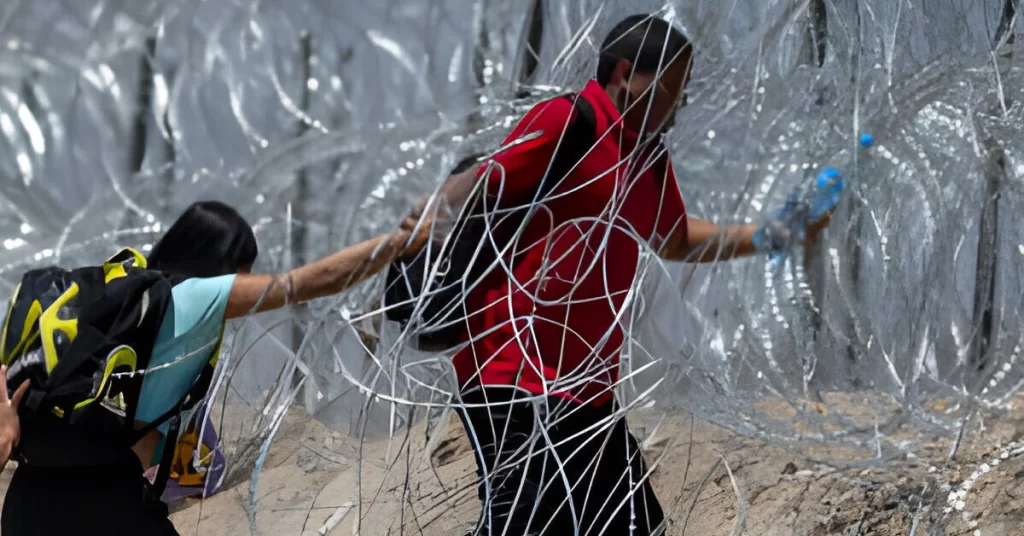Migrants Flood Border, Ignoring Crackdown:10 Signs
Migrants continue to pour across the southern border of the US in groups of hundreds, despite the Joe Biden administration’s latest efforts to crack down on illegal crossings. The administration’s recent measures, including policies aimed at deterring unauthorized entry and enhancing border security, have not significantly curbed the influx of migrants. These groups, often including families and unaccompanied minors, persist in their attempts to enter the United States, highlighting the ongoing challenges in managing and securing the border. The continued crossings underscore the complex factors driving migration and the limitations of current deterrence strategies, necessitating a more comprehensive approach to address the root causes and humanitarian needs of migrants.
Hundreds of migrants, mostly from China and Turkey, were captured on camera on Thursday by The Post showing them entering California illegally before being apprehended by Border Patrol officers. Even with the recent actions taken by the Biden administration to tighten down on illegal crossings, these groups still arrive in sizable numbers. The video emphasizes the continuous difficulties border security faces in controlling the flood of migrants from many regions, illustrating the intricate and enduring character of migrant flows into the United States.
Another video, which The Post was able to secure, shows a large number of migrants from Central and South America entering private land in Normandy, Texas on Wednesday. The location is rural. Then state troopers came to gather them up. Large numbers of migrants continue to enter the country through rural areas despite heightened measures and patrols, as this clip highlights the persistent issues faced by border authorities in these locations. Given the ongoing influx of migrants into the United States from diverse regions, the situation in Normandy is indicative of the larger problems at the southern border and emphasizes the necessity of comprehensive and efficient border management techniques.
Many migrants crossed the US-Mexico border undeterred in spite of President Biden’s executive order, which capped asylum processing at 2,500 migrants for seven days in an effort to discourage illegal crossings. The executive order stopped processing asylum petitions after a certain number of days in an effort to reduce illegal immigration. Nevertheless, immigrants continued to make efforts to reach the US, largely unaffected by this step. The current migrant crisis emphasizes how difficult it is to establish efficient border control procedures and deal with the underlying issues that lead to migration in spite of legal restrictions. This circumstance emphasizes the necessity of all-encompassing and compassionate solutions to efficiently manage migratory flows while respecting ethical and legal norms.
Executive orders take effect on Wednesday and state that border restrictions will only be removed when daily crossings average 1,500 or more for seven days in a row. By establishing a threshold that must be reached before reducing limitations, this approach aims to control the migrant inflow. The policy, which reflects the administration’s continuous efforts to strike a balance between enforcement and humanitarian considerations, aims to decrease the number of unlawful crossings and better regulate the flow of migrants.
Read More:Hunter Biden Trial On 3 Criminal Gun Charges Begins
Alejandro Mayorkas, secretary of the Department of Homeland Security (DHS), said that the new executive order is intended “to deter irregular migration.” By placing limits and thresholds, this approach aims to control and lessen the number of people entering the country illegally. In order to address the issues of illegal entry and enhance border security generally, the order seeks to promote the adoption of lawful migration channels and processes. The administration anticipates that by taking these steps, migratory flows will become more controlled and orderly, striking a balance between humanitarian concerns and law enforcement.
However, according to agency sources who spoke to The Post, Border Patrol agents detained 10,000 people that day in addition to apprehending 4,000 illegal migrants along the southern border on Thursday alone. This large number of arrests shows that, in spite of new laws and initiatives to discourage unauthorized immigration, there are still many difficulties and a large number of people trying to cross the border. The overwhelming volume of detainees highlights the strain on Border Patrol resources as well as the difficulties in efficiently overseeing immigration enforcement and border security.
San Diego, which has been the main region for unauthorized crossings, has 237% of its Border Patrol processing centers full as of Thursday. Internal statistics showed that these centers were housing about 2,300 migrants in spaces meant to house 1,000. The severe overcapacity highlights the tremendous burden that officials are placing on infrastructure and resources in trying to handle the large number of migrants. The predicament emphasizes how urgently more assistance and increased capacity are needed in order to adequately manage the ongoing influx.
not deterred by the recent enforcement actions taken by the Biden administration against unauthorized crossings. Videos obtained by The Post reveal a significant number of migrants from China and Turkey crossing the border into California, where they were later detained by Border Patrol officials, despite recent efforts to discourage unauthorized incursions. More footage from rural Texas shows Central and South American migrants entering Normandy, Texas, on private property before state troopers apprehend them.
These occurrences highlight the continuous difficulties the Biden administration has in overseeing and protecting the US-Mexico border. The presidential order went into effect on Wednesday and is intended to halt the processing of asylum claims once 2,500 migrants have been detained for unauthorized entry during a period of seven days. The objective of this strategy is to deter migrants from trying to cross the border illegally by capping the number of asylum requests made each day. The ongoing flood of immigrants, however, indicates that this step may not have had the intended deterrent impact.
According to Alejandro Mayorkas, secretary of the Department of Homeland Security (DHS), the main goal of the executive order is “to deter irregular migration.” Nonetheless, there are doubts about this measure’s efficacy. According to reports from The Post, Border Patrol agents detained 10,000 people on Thursday alone, in addition to apprehending 4,000 illegal migrants at the southern border.
The primary objective of the presidential order, according to Department of Homeland Security (DHS) chief Alejandro Mayorkas, is “to deter irregular migration.” However, there are questions regarding the effectiveness of this measure. The Post writes that on Thursday alone, Border Patrol agents arrested 4,000 illegal migrants along the southern border and detained 10,000 people.
Speaking anonymously to The Post, a Border Patrol agent expressed doubts about the effectiveness of the executive order and predicted that large-scale releases of undocumented immigrants into the United States will go on. The agent made note of the fact that certain nations—like China—do not welcome frequent US deportation flights and take a long time to provide travel papers to those who are subject to deportation. The implementation of deportations is complicated by this political and logistical obstacle, which forces the release of migrants who cannot be quickly deported.
“It sounds like Mexico is going to be taking back individuals from a handful of countries,” the agent went on to say. The remaining material will be processed and sent to ICE. But they will just be freed if there are no detention facilities or flights for repatriation, which is the original cause of this whole fiasco. This viewpoint draws attention to how inadequate present policies are to address the underlying issues and real-world difficulties associated with illegal migration.
The Biden administration has implemented some major policy changes, including the removal of Title 42 and the reinstatement of Title 8 enforcement. During the COVID-19 epidemic, Title 42, which was first put into effect by the Trump administration, permitted the quick removal of migrants in order to stop the virus from spreading. Critics countered that it resulted in multiple violations of human rights and circumvented the lawful right to apply for refuge.
The Biden administration seeks to uphold immigration rules under Title 8 while giving asylum seekers due process. A component of the Title 8 framework, the Circumvention of Lawful Pathways Rule presumes that individuals who do not use lawful pathways—like the CBP OneTM app—are ineligible for asylum. The goal of this regulation is to lower the number of illegal crossings by encouraging migrants to use the proper procedures. Human rights organizations, on the other hand, have criticized it as well, claiming that it may not sufficiently address the nuanced reasons why people leave their own nations.
The situation at the US-Mexico border is still vital and changing. The management of migration flows and the provision of humanitarian aid to migrants continue to present difficulties in spite of considerable policy initiatives and international collaboration. In an effort to establish a more efficient and compassionate system, the Biden administration is still navigating the complicated terrain of immigration enforcement, public opinion, and political ramifications. In order to address the underlying causes of migration and enhance border control, long-term solutions would necessitate consistent efforts, regional cooperation, and substantial changes.








